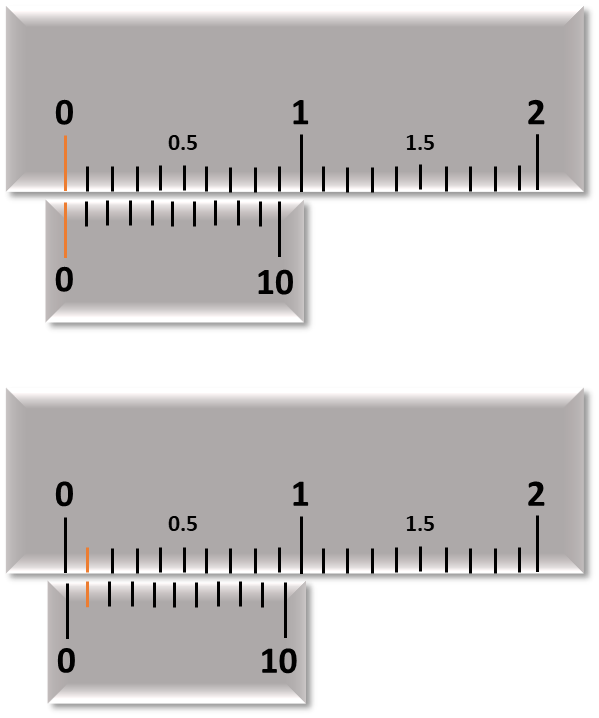
Vernier constant is the:
(A). Value if one MSD divided by total number of divisions on the main scale
(B). Value of one VSD divided by total number of divisions on the main scale
(C). Total number of divisions on the main scale divided by total number of divisions on the Vernier scale
(D). Difference between the value of one main scale division and one Vernier scale division
Answer
595.8k+ views
- Hint: Vernier constant or the least count of a Vernier caliper is the least distance that can be measured by the scale.
Complete step-by-step solution -
Vernier caliper is an assistive tool, used to take accurate reading between two markings (graduation) of a main scale. It is a subsidiary scale that increases the resolution of measurement.
In a Vernier caliper, 10 divisions of the Vernier scale coincide with 9 divisions of the main scale. Now the Vernier scale is shifted such that its first marking coincides with the first marking of the main scale. In this situation the difference between the zeroth marking of each scale gives the smallest length that the Vernier caliper can measure. Since, the first marking is coinciding, the required length is the difference between 1 main scale division (msd) (1 msd = 1 mm) and 1 Vernier scale division (vsd).

Now, since
$10 vsd = 9 msd$
$1 vsd = \dfrac{9}{10} msd$
$1 vsd = \dfrac{9}{10} mm$
Hence, the required length or the Vernier constant (VC) is given by,
$VC = 1 msd – 1vsd$
$VC = 1 mm - \dfrac{9}{10} mm $
$VC = \dfrac{1}{10} mm $
Hence, Vernier constant is the difference between the value of one main scale division and one Vernier scale division.
Therefore, the correct option is D.
Note: It is easy to remember that the least count is equal to the least count of the main scale divided by the number of divisions in the Vernier scale. The same logic applies for screw gauge.
Complete step-by-step solution -
Vernier caliper is an assistive tool, used to take accurate reading between two markings (graduation) of a main scale. It is a subsidiary scale that increases the resolution of measurement.
In a Vernier caliper, 10 divisions of the Vernier scale coincide with 9 divisions of the main scale. Now the Vernier scale is shifted such that its first marking coincides with the first marking of the main scale. In this situation the difference between the zeroth marking of each scale gives the smallest length that the Vernier caliper can measure. Since, the first marking is coinciding, the required length is the difference between 1 main scale division (msd) (1 msd = 1 mm) and 1 Vernier scale division (vsd).

Now, since
$10 vsd = 9 msd$
$1 vsd = \dfrac{9}{10} msd$
$1 vsd = \dfrac{9}{10} mm$
Hence, the required length or the Vernier constant (VC) is given by,
$VC = 1 msd – 1vsd$
$VC = 1 mm - \dfrac{9}{10} mm $
$VC = \dfrac{1}{10} mm $
Hence, Vernier constant is the difference between the value of one main scale division and one Vernier scale division.
Therefore, the correct option is D.
Note: It is easy to remember that the least count is equal to the least count of the main scale divided by the number of divisions in the Vernier scale. The same logic applies for screw gauge.
Recently Updated Pages
A man running at a speed 5 ms is viewed in the side class 12 physics CBSE

The number of solutions in x in 02pi for which sqrt class 12 maths CBSE

State and explain Hardy Weinbergs Principle class 12 biology CBSE

Write any two methods of preparation of phenol Give class 12 chemistry CBSE

Which of the following statements is wrong a Amnion class 12 biology CBSE

Differentiate between action potential and resting class 12 biology CBSE

Trending doubts
What are the major means of transport Explain each class 12 social science CBSE

Which are the Top 10 Largest Countries of the World?

Draw a labelled sketch of the human eye class 12 physics CBSE

Explain sex determination in humans with line diag class 12 biology CBSE

Explain sex determination in humans with the help of class 12 biology CBSE

Differentiate between homogeneous and heterogeneous class 12 chemistry CBSE




